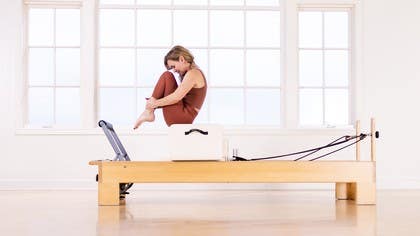
What to Expect Your First Time on a Reformer
For a beginner, a Pilates Reformer can appear more foe than friend. With long, wily straps, a large frame and moving platform, there’s good reason for the trope that this particular Pilates apparatus looks like a medieval torture device. But there’s no reason to fear the Reformer, especially if you know what to expect before your first attempt at Footwork or Knee Stretches. You, too, can master (or at least, control) the Reformer and other Pilates apparatus with a little help and a little practice.
Here’s what to expect your first time on a Reformer for Pilates at home or in the studio:
1. The carriage moves, and so will you.
Moving without gravity is one of the hallmarks of equipment-based Pilates and one of its great joys. But lying on your back (supine) on a moving platform can feel disorienting, even weird.
The more you use the equipment - and use caution and safety at all times - the more comfortable you will be in all your movements. The goal is to experience the motion of the carriage. You're in charge, and you can control it all.
Close your eyes, take a deep breath, and exhale. You got this.
Watch Footwork on the Reformer:
2. You will feel as coordinated as a baby giraffe.
Listening for and learning cues, learning to use new muscles, and learning to use new equipment can throw anyone for a loop. There’s a lot going on!
If you’re practicing at home Pilates, lucky you. You have the freedom to explore, to experiment, and to make mistakes with no one watching.
If you're in the studio, though, you might be next to a cadre of ballet dancers or someone who thinks she’s a ballet dancer (but really isn’t). It’s okay to check out what your classmates are doing; your experienced neighbor can be a good guide through the class. Go ahead, be inspired, just don’t be discouraged or intimidated by “Miss Balenchine” to your left. If you feel out of place, know that every person in the world has felt this way at some point in their Pilates practice.
Over time, you will build connections, learn proper form, and know what feels good to your body. Right now, though, it's all new, and it doesn't have to be perfect. So, you do you.
3. The springs are like a box of chocolates.
Pilates equipment uses springs with varying degrees of tension that are connected to one side of the Reformer. The springs provide both resistance and support for your exercises. The number and strength of springs vary from exercise to exercise, and the springs on the equipment can vary depending on the equipment manufacturer.
If you're practicing at home, check your owner's manual. In a group class, listen to your teacher. Most importantly, listen to your body. A heavier spring might make your workout more challenging while at the same time help you perform an exercise better or help you connect to your muscles. Then again, a heavier spring can make exercise easier because it requires you to use less of your own body weight.
4. You get props.
Not the congratulatory kind (though, you will get those, too). We're talking about balls and Therabands. The Reformer is a work of wonder, to be sure, but Pilates teachers often incorporate props like Magic Circles to help you connect to your muscles and to help improve your form. It's all part of the fun.
5. You will break a sweat...eventually.
Pilates is a full body workout. When you are focused and concentrating (two of the Principles of Pilates) on your body and your movements, you are maximizing your energy output. Your muscles will warm up (you may even "feel the burn"), you will use muscles that you typically don't use, and if done correctly, you will engage every.part.of.your.body. What if you’re not dripping with sweat by the end? You likely got a good workout. As you practice more and more, you will learn to go deeper and properly engage. And when you do, have those handy wipes handy.
Focus on the workout, breathe, and have fun. At the end you can give yourself a different kind of prop - a pat on the back - for giving Pilates a go!
Comments

You need to be a subscriber to post a comment.
Please Log In or Create an Account to start your free trial.

















